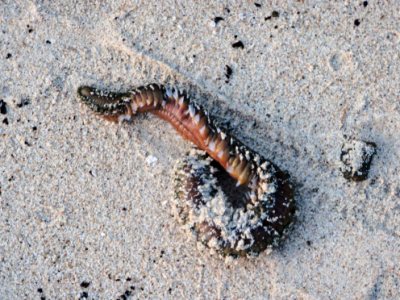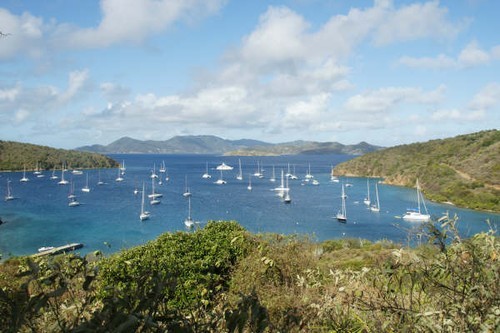Norman Island

|
Norman Island
After our success in laying to rest Bernie's symbol of all things unkind, it was time to find a buoy in the sheltered anchorage of The Bight on Norman Island.
As soon as we set foot ashore we saw a huge stingray playing in the shallows. Then we saw this sea worm, turned him gently over for a closer look.
Our cruising guide says: Norman is one of the islands making up the perimeter of the Sir Francis Drake Channel. Often referred to by the locals as "Treasure Island". A letter of 1750 stated, "Recovery of the treasure from Nuestra Senora buried on Norman Island, comprising $450,000 dollars, plate, cochineal, indigo, tobacco, much dug up by the Tortolians".
Wikipedia says: Norman Island is located at
the southern tip of the BVI's archpelago. It is reputed to be the inspiration
for Robert Louis Stevenson's pirate novel Treasure Island.
History:
It is said
that the island was named after a pirate who bought it or leased it at some
point during the early 18th century, although supporting evidence for this
contention is difficult to find. However,
Norman Island also has a documented history of pirate booty being stowed upon
the island. In August of 1750 a Spanish treasure galleon named Nuestra Senora de
Guadeloupe sought shelter from a storm on the North Carolina coast. The crew
mutinied and the treasure, said to consist of (amongst other things) fifty
five chests of silver coins, was loaded into two Bilanders, one of which was
manned by Owen Lloyd. The first vessel perished, but Lloyd escaped to St Croix.
After disposing of some of the money, he proceeded to Norman Island where the
treasure was buried. Lloyd and his crew were later arrested in St. Eustatius,
but word of the treasure spread, and residents of Tortola went to Norman Island
and dug it up for themselves. Part of the booty was later recovered by Gilbert
Fleming, Lieutenant-General of the Leeward Islands at the time, who travelled to
Tortola with two companies of soldiers. Fleming persuaded Abraham Chalwill, the
acting Lieutenant Governor of the British Virgin Islands (who had coincidentally
lead the search for the treasure on Norman Island) to issue a proclamation
whereby the treasure would be returned and the people who had dug it up would
receive a one-third share as a reward. There the
historical record ends, but local rumours abound that a member of a well-known
local family had been fishing near Norman Island and took shelter in one of the
caves on the Western coast of Norman Island during a storm. The surge repeatedly
banged his small boat against the walls of the cave, whilst the storm surge
caused the water level to rise several feet. When the fortunate fisherman woke
the next morning, a large number of rocks had broken off into his small craft,
as had a small chest, supposedly filled with gold doubloons. The story cannot be
verified as no legal application for treasure trove was ever made but it is
known that members of the family ceased being fisherman and left Tortola at
about the time to open some shops in Charlotte Amelie in St.
Thomas. Rumours persist of more pirate gold to be found on Norman Island, although to date no applications have ever been made for treasure trove.
  It's not
often I shock Jump, but, saying "Do you want a suck
from my bucket" perhaps just did. Jump wanted a cup of tea, Bear bought us two
a bucket of Painkiller.
Today: The island
is uninhabited and privately owned by Dr Henry Jarecki. Its area is about six
hundred acres (2.4 km²), and is about 2.5 miles long. A large harbour known as
"The Bight" offers one of the most protected anchorages in the area. It is
considered to be one of the "Little Sisters," along with the islands - Pelican,
Peter, Salt, Ginger and Dead Chest Island. This group of islands is smaller,
lower and more arid than other islands to the north and
west. Norman Island is a well-known destination for cruisers and other tourists because of three water-level caves at the base of cliffs just outside the western edge of The Bight. The caves are ideal for snorkeling, and push deeply enough into the cliffs that darkness makes the experience like a night dive.
The island
has no permanent inhabitants (other than wild goats), but there is a restaurant
and bar named "Pirates" located in the Bight. There is also an old barge named
the William Thornton (or "Willie T" to locals) which
operates as a bar and restaurant. In the television show The Jeffersons one of the characters is from the Caribbean island of "St. Norman". This is probably an inside joke since the creator of the show was Norman Lear.
   Whatever
Norman Island is or is not, it will go down in our history as the first place we
saw a 'Mr Pecalin' landing and sitting smiling on a
tree
Our Imray textbook says: Norman Island is best known for its caves and buried treasure. According to some, Robert Louis Stevenson had learned of the discovery of this treasure through an old letter of his grandfather, and that inspired him to write Treasure Island. Others talk of an old family with French origins who found Spanish doubloons in a cave in 1900. Whatever the truth really is, why not keep the legend going anyway?
|



